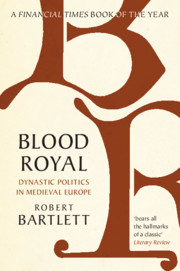Book contents
- Blood Royal
- The James Lydon Lectures in Medieval History and Culture
- Blood Royal
- Copyright page
- Dedication
- Contents
- Figures
- Preface and Acknowledgements
- Abbreviations
- Introduction Royal Families
- Part I The Life Cycle
- Part II A Sense of Dynasty
- Chapter 8 Names and Numbering
- Chapter 9 Saints, Images, Heraldry, Family Trees
- Chapter 10 Responses to Dynastic Uncertainty: Prophecy and Astrology
- Chapter 11 Pretenders and Returners: Dynastic Imposters in the Middle Ages
- Chapter 12 New Families and New Kingdoms
- Chapter 13 Dynasties and the Non-Dynastic World
- Conclusion
- Book part
- Notes
- Bibliography of Works Cited
- Index
Chapter 13 - Dynasties and the Non-Dynastic World
from Part II - A Sense of Dynasty
Published online by Cambridge University Press: 09 July 2020
- Blood Royal
- The James Lydon Lectures in Medieval History and Culture
- Blood Royal
- Copyright page
- Dedication
- Contents
- Figures
- Preface and Acknowledgements
- Abbreviations
- Introduction Royal Families
- Part I The Life Cycle
- Part II A Sense of Dynasty
- Chapter 8 Names and Numbering
- Chapter 9 Saints, Images, Heraldry, Family Trees
- Chapter 10 Responses to Dynastic Uncertainty: Prophecy and Astrology
- Chapter 11 Pretenders and Returners: Dynastic Imposters in the Middle Ages
- Chapter 12 New Families and New Kingdoms
- Chapter 13 Dynasties and the Non-Dynastic World
- Conclusion
- Book part
- Notes
- Bibliography of Works Cited
- Index
Summary
This chapter looks at elective monarchy and also the way dynasties interacted with powers of a non-dynastic nature. The papacy is a notable example of elective monarchy but the most important case of elective kingship is the Holy Roman Empire, where the long-term dynasties of the tenth to thirteenth centuries never completely eroded the elective principle, and where the later Middle Ages saw seven different dynasties in power. Although the Church offered the chance of ecclesiastical office to members of the aristocracy throughout Europe, the ruling dynasties did not follow their practice of placing younger sons in the Church to any extent, though royal women were placed in monasteries. Republics, though rare, could be found in Venice and Iceland, and embryonic republican institutions arose in many of the larger cities, and this often led to conflict between towns and their nominal dynastic overlords, notably in the case of the Holy Roman Emperors and the Lombard Leagues of northern Italy. Relations might also be tense between dynasties and the kingdoms they ruled, where the community of the realm, perhaps organized in representative estates, might well decide it had its own interests distinct from and possibly antagonistic to its dynastic sovereigns.
- Type
- Chapter
- Information
- Blood RoyalDynastic Politics in Medieval Europe, pp. 397 - 428Publisher: Cambridge University PressPrint publication year: 2020



